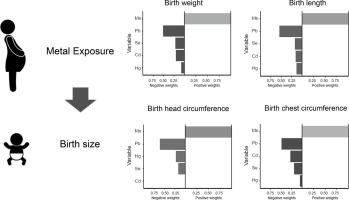Environment International ( IF 11.8 ) Pub Date : 2022-05-23 , DOI: 10.1016/j.envint.2022.107318 Tomozumi Takatani 1 , Akifumi Eguchi 2 , Midori Yamamoto 2 , Kenichi Sakurai 2 , Rieko Takatani 2 , Yu Taniguchi 3 , Shoji F Nakayama 3 , Chisato Mori 4 , Michihiro Kamijima 5 ,

|
Background
Growth restriction in the prenatal period is a significant public health concern. Metals can negatively affect birth size, and pregnant women may be exposed to metal mixtures. Comprehensive studies analyzing the effects of combined metal exposure with accurate individual blood metal concentrations are limited. The current study investigated the associations between maternal metal exposure and birth size in a large, nationwide Japanese cohort using individual and mixed model approaches.
Methods
Lead, cadmium, mercury, selenium, and manganese blood concentrations were measured in pregnant women in the Japan Environment and Children’s Study (JECS). Measurements of infant birth size—including body weight, body length, and head and chest circumference—were collected. Linear and logistic regressions were used for birth size measurements and the odds of an infant being small in size for gestational age, respectively. Associations between combined metal mixtures and measurements at birth were evaluated using quantile g-computation and Bayesian kernel machine regression (BKMR).
Results
Of the 103,060 JECS pregnancies, 93,739 mother–infant pairs were analyzed. The linear regression models showed that lead, selenium, cadmium, and manganese—but not mercury—were associated with body weight. Cadmium was associated with length and chest circumference and mercury was associated with head circumference. Quantile g-computation revealed that manganese increased infant birth weight, length, head circumference, and chest circumference. Lead was the strongest negative factor for infant birth weight, length, head circumference, and chest circumference. The BKMR analysis revealed that the metals had an additive, rather than a synergistic effect.
Conclusion
Metal exposure is associated with infant birth size, with lead and manganese playing a more significant role in Japan. The effects of prenatal combined metal exposure at low levels warrant public health attention.
中文翻译:

与出生大小相关的个体和混合金属母体血液浓度:日本环境和儿童研究 (JECS) 的分析
背景
产前生长受限是一个重要的公共卫生问题。金属会对出生体型产生负面影响,孕妇可能会接触到金属混合物。分析金属暴露与准确的个体血液金属浓度的影响的综合研究是有限的。目前的研究使用个体和混合模型方法调查了一个大型全国性日本队列中母体金属暴露与出生体型之间的关联。
方法
在日本环境和儿童研究 (JECS) 中测量了孕妇血液中的铅、镉、汞、硒和锰浓度。收集了婴儿出生尺寸的测量值,包括体重、体长、头围和胸围。线性回归和逻辑回归分别用于出生大小测量和婴儿小于胎龄的几率。使用分位数 g 计算和贝叶斯核机器回归 (BKMR) 评估组合金属混合物与出生时测量值之间的关联。
结果
在 103,060 次 JECS 妊娠中,分析了 93,739 对母婴。线性回归模型显示铅、硒、镉和锰——但不是汞——与体重相关。镉与长度和胸围有关,而汞与头围有关。分位数 g 计算显示,锰会增加婴儿出生体重、身长、头围和胸围。铅是影响婴儿出生体重、身长、头围和胸围的最强负面因素。BKMR 分析表明,这些金属具有添加剂,而不是协同效应。
结论
金属接触与婴儿出生大小有关,铅和锰在日本发挥着更重要的作用。低水平的产前复合金属暴露的影响值得公共卫生关注。


























 京公网安备 11010802027423号
京公网安备 11010802027423号